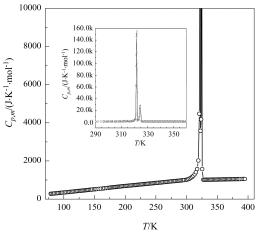1 Li, J.-L.; Xue, P.; Ding, W.-Y.; Han, J.-M.; Sun, G.-L. Sol. Energy Mater. Sol. Cells 2009, 93, 1761.  2 Kang, J. K.; Choy, J. H.; Madeleine, R. L. J. Phys. Chem. Solids 1993, 54, 1567. 2 Kang, J. K.; Choy, J. H.; Madeleine, R. L. J. Phys. Chem. Solids 1993, 54, 1567.  3 Li, W.-P.; Zhang, D.-S.; Zhang, T.-P.; Wang, T.-Z.; Ruan, D.-S.; Xing, D.-Q.; Li, H.-B. Thermochim. Acta 1999, 326,183. 3 Li, W.-P.; Zhang, D.-S.; Zhang, T.-P.; Wang, T.-Z.; Ruan, D.-S.; Xing, D.-Q.; Li, H.-B. Thermochim. Acta 1999, 326,183.  4 Wu, K.-Z.; Zhang, J.-J.; Liu, X.-D. Thermochim. Acta 2009,483, 55. 4 Wu, K.-Z.; Zhang, J.-J.; Liu, X.-D. Thermochim. Acta 2009,483, 55.  5 Arend, H.; Huber, W. J. Cryst. Growth 1978, 43, 213. 5 Arend, H.; Huber, W. J. Cryst. Growth 1978, 43, 213.  6 Hawes, D. W.; Banu, D.; Feldman, D. Sol. Energy Mater.1990, 21, 61. 6 Hawes, D. W.; Banu, D.; Feldman, D. Sol. Energy Mater.1990, 21, 61.  7 Lee, K. W.; Lee, C. E.; Kim, J.; Kang, J. K. Solid State Commun. 2002, 124, 185. 7 Lee, K. W.; Lee, C. E.; Kim, J.; Kang, J. K. Solid State Commun. 2002, 124, 185.  8 Kong, Y.-X.; Di, Y.-Y.; Yang, W.-W.; Lü, Y.-F.; Tan, Z.-C. Chin. J. Chem. 2010, 28, 521.9 Liu, Y.-P.; Di, Y.-Y.; Dan, W.-Y.; He, D.-H. Z. Phys. Chem. 2010, 224, 1371.10 Wu, K.-Z.; Zhang, J.-J.; Liu, X.-D. Thermochim. Acta.2009, 483, 55. 8 Kong, Y.-X.; Di, Y.-Y.; Yang, W.-W.; Lü, Y.-F.; Tan, Z.-C. Chin. J. Chem. 2010, 28, 521.9 Liu, Y.-P.; Di, Y.-Y.; Dan, W.-Y.; He, D.-H. Z. Phys. Chem. 2010, 224, 1371.10 Wu, K.-Z.; Zhang, J.-J.; Liu, X.-D. Thermochim. Acta.2009, 483, 55.  11 Arend, H.; Huber, W. J. Cryst. Growth 1978, 43, 213. 11 Arend, H.; Huber, W. J. Cryst. Growth 1978, 43, 213.  12 He, D.-H.; Di, Y.-Y.; Tan, Z.-C.; Yi, F.-F.; Dan W.-Y.; Liu, Y.-P. Sol. Energy Mater. Sol. Cells 2011, 95, 2897. 12 He, D.-H.; Di, Y.-Y.; Tan, Z.-C.; Yi, F.-F.; Dan W.-Y.; Liu, Y.-P. Sol. Energy Mater. Sol. Cells 2011, 95, 2897.  13 He, D.-H.; Di, Y.-Y.; Yao, Y.; Liu, Y.-P.; Dan, W.-Y. J. Chem. Eng. Data 2010, 55, 5739. 13 He, D.-H.; Di, Y.-Y.; Yao, Y.; Liu, Y.-P.; Dan, W.-Y. J. Chem. Eng. Data 2010, 55, 5739.  14 Liu, Y.-P.; Di, Y.-Y.; Xing, Y.-T.; Zhang, P. J. Chem. Thermodyn. 2010, 42, 513. 14 Liu, Y.-P.; Di, Y.-Y.; Xing, Y.-T.; Zhang, P. J. Chem. Thermodyn. 2010, 42, 513.  15 Di, Y.-Y.; Tan, Z.-C.; Li, Y.-S. Acta Chim. Sinica 2006, 64,1393 (in Chinese). (邸友莹, 谭志诚, 李彦生, 化学学报, 2006, 64, 1393.) 15 Di, Y.-Y.; Tan, Z.-C.; Li, Y.-S. Acta Chim. Sinica 2006, 64,1393 (in Chinese). (邸友莹, 谭志诚, 李彦生, 化学学报, 2006, 64, 1393.)  16 Archer, D. G. J. Phys. Chem. Ref. Data 1993, 22, 1441. 16 Archer, D. G. J. Phys. Chem. Ref. Data 1993, 22, 1441.  17 Jenkins, H. D. B.; Tudela, D.; Glasser, L. Inorg. Chem.2002, 41, 2364. 17 Jenkins, H. D. B.; Tudela, D.; Glasser, L. Inorg. Chem.2002, 41, 2364.  18 Di, Y.-Y.; Chen, J.-T.; Tan, Z.-C. Thermochim. Acta 2008,471, 70. 18 Di, Y.-Y.; Chen, J.-T.; Tan, Z.-C. Thermochim. Acta 2008,471, 70.  19 Kong, Y.-X.; Li, Y.-B.; Yang, W.-W.; Di, Y.-Y.; Shi, Q.; Tan, Z.-C. Acta Chim. Sinica 2008, 66(6), 609 (in Chinese). (孔玉霞, 李月宝, 杨伟伟, 邸友莹, 史全, 谭志诚, 化学 学报, 2008, 66(6), 609.)20 Di, Y.-Y.; Hong, Y.-P.; Kong, Y.-X. J. Chem. Thermodyn.2009, 41, 80. 19 Kong, Y.-X.; Li, Y.-B.; Yang, W.-W.; Di, Y.-Y.; Shi, Q.; Tan, Z.-C. Acta Chim. Sinica 2008, 66(6), 609 (in Chinese). (孔玉霞, 李月宝, 杨伟伟, 邸友莹, 史全, 谭志诚, 化学 学报, 2008, 66(6), 609.)20 Di, Y.-Y.; Hong, Y.-P.; Kong, Y.-X. J. Chem. Thermodyn.2009, 41, 80.  21 Guo, N.; Wang, W. Chin. J. Appl. Chem. 1994, 11(4), 25 (in Chinese). (郭宇, 王玮, 应用化学, 1994, 11(4), 25.)22 Lee, C. H.; Lee, K. W.; Lee, C. E. Curr. Appl. Phys. 2003,3, 477. 21 Guo, N.; Wang, W. Chin. J. Appl. Chem. 1994, 11(4), 25 (in Chinese). (郭宇, 王玮, 应用化学, 1994, 11(4), 25.)22 Lee, C. H.; Lee, K. W.; Lee, C. E. Curr. Appl. Phys. 2003,3, 477.  23 Guo, N.; Wang, W.; Zeng, G.-F.; Xi, S.-Q. Acta Chim. Sinica 1994, 52, 705 (in Chinese). (郭宁, 王玮, 曾广赋, 席时权, 化学学报, 1994, 52, 705.) 23 Guo, N.; Wang, W.; Zeng, G.-F.; Xi, S.-Q. Acta Chim. Sinica 1994, 52, 705 (in Chinese). (郭宁, 王玮, 曾广赋, 席时权, 化学学报, 1994, 52, 705.) |
